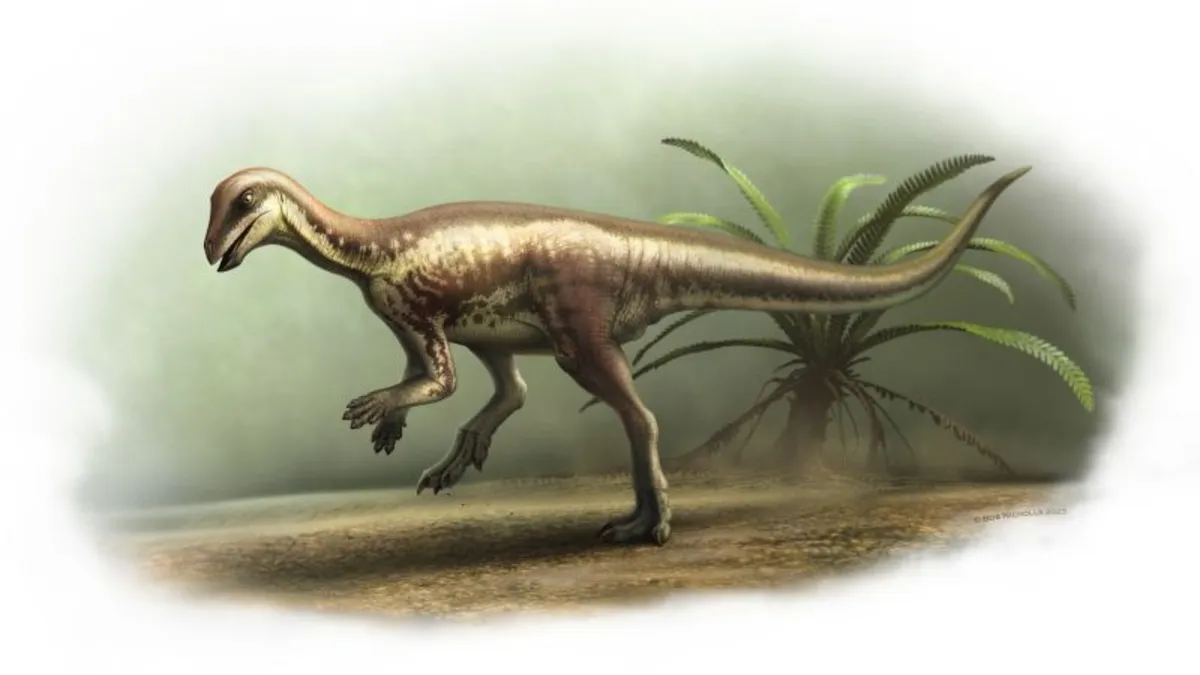
Sign up for CNN’s Wonder Theory science newsletter and explore the universe with news on fascinating discoveries and scientific advancements. Recently, scientists made an exciting discovery — a new species of dinosaur named Enigmacursor mollyborthwickae. This remarkable creature was approximately the size of a Labrador retriever and roamed the land that is now the United States around 150 million years ago, coexisting with well-known dinosaurs such as the stegosaurus and diplodocus.
According to a study published in the Royal Society Open Science, Enigmacursor mollyborthwickae had a unique physique — its tail accounted for about half of its total length. Despite the discovery of many bones from this dinosaur in the Morrison Formation of Colorado between 2021 and 2022, researchers found that parts of its skull and vertebral column were missing. This absence leaves scientists uncertain about its exact measurements and length.
Professor Paul Barrett, a researcher at London’s Natural History Museum and co-lead of the study, noted, “These very small plant-eating dinosaurs are pretty rare to find. Actually discovering a substantially complete skeleton rather than a few bits and pieces of bones is uncommon, which is why they remain fairly poorly understood.” Visitors can look forward to seeing the skeleton on display at the Natural History Museum starting June 26.
Barrett described the dinosaur as “lightly built,” with a weight comparable to that of a collie. As a herbivore, Enigmacursor mollyborthwickae walked on its long hind legs, suggesting it was a speedy runner capable of making a quick getaway from predators. Barrett added, “This adaptation would have been beneficial for survival in its ecosystem.”
Barrett and his colleague, Susannah Maidment, began their investigation after a London art gallery contacted them regarding the dinosaur. They collaborated with the gallery to find a donor, which led to the skeleton's eventual arrival at the museum. The species name, mollyborthwickae, honors the donor, while the genus name translates to “mysterious runner” in Latin.
Upon close examination of the bones, Maidment and Barrett determined that this specimen exhibited unique characteristics that set it apart from previously known species. Notably, its thigh bone displayed distinct muscle attachments, making it unlike any other dinosaur. Interestingly, Enigmacursor mollyborthwickae is most closely related to Yandusaurus hongheenis, a three-meter-long dinosaur unearthed in China. This relationship suggests that the species had a widespread distribution, leading Barrett to hypothesize that other fossils may exist but remain undiscovered.
Scientists believe that Enigmacursor mollyborthwickae was not fully grown, as some of its vertebrae had yet to fuse. However, due to the fossil preparation process prior to its arrival at the Natural History Museum, they cannot confirm its age at death. Additionally, it remains unclear how this dinosaur met its demise, as there are no apparent signs of illness or injury in its bones.
Barrett explained that new species of dinosaurs are frequently unearthed or identified, approximately once a week. However, the discovery of smaller dinosaurs like Enigmacursor mollyborthwickae is much rarer. This rarity is attributed to fossil hunters often focusing on larger, more impressive specimens, while smaller skeletons are more susceptible to damage from predators and scavengers. Finding these smaller dinosaurs plays a crucial role in enriching our understanding of ancient ecosystems, Barrett emphasized.
Stay updated on such fascinating discoveries by signing up for CNN’s Wonder Theory science newsletter!